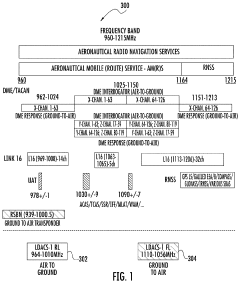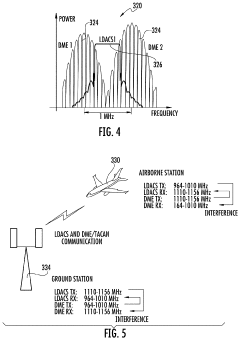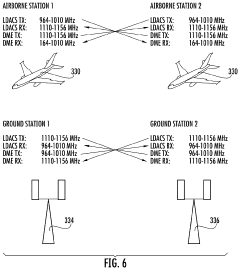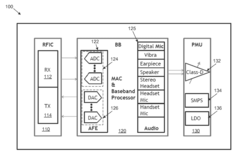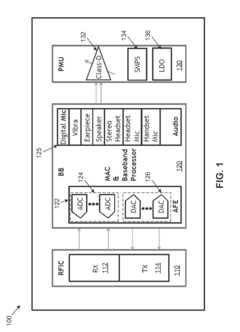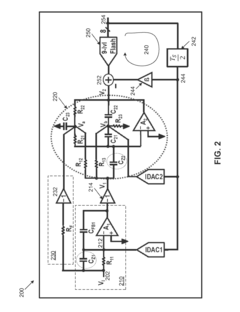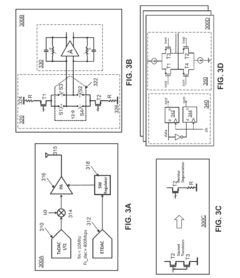How LDAC Supports Superior Mobile Audio Experiences?
JUL 4, 20258 MIN READ
Generate Your Research Report Instantly with AI Agent
Patsnap Eureka helps you evaluate technical feasibility & market potential.
LDAC Technology Overview and Objectives
LDAC, developed by Sony in 2015, represents a significant advancement in wireless audio technology. This codec aims to deliver high-resolution audio over Bluetooth connections, addressing the growing demand for superior sound quality in mobile devices. LDAC's primary objective is to overcome the limitations of traditional Bluetooth audio codecs, which often compromise audio fidelity due to bandwidth constraints.
The technology behind LDAC is designed to transmit audio data at up to 990 kbps, which is approximately three times the data rate of conventional Bluetooth audio codecs. This increased bandwidth allows for the transmission of audio files with minimal loss of quality, preserving the nuances and details of high-resolution recordings. LDAC supports sampling rates up to 96 kHz and bit depths of 24 bits, enabling it to handle a wide range of audio formats and maintain fidelity across various types of music and audio content.
One of the key goals of LDAC is to provide a more immersive and authentic listening experience for mobile users. By reducing the compression of audio data, LDAC aims to preserve the original sound characteristics, including subtle harmonics and spatial information that are often lost in heavily compressed formats. This approach aligns with the growing trend of high-resolution audio streaming services and the increasing availability of high-quality audio content.
LDAC's development is part of a broader technological evolution in wireless audio transmission. It builds upon earlier codecs like SBC (Sub-Band Coding) and aptX, pushing the boundaries of what is possible over Bluetooth connections. The technology's adaptive bit rate feature allows it to adjust its data transmission rate based on the connection quality, ensuring optimal performance across various usage scenarios.
As mobile devices continue to replace traditional audio equipment for many consumers, LDAC seeks to bridge the gap between convenience and audio quality. Its implementation in smartphones, tablets, and wireless headphones aims to satisfy the demands of audiophiles and casual listeners alike, offering a compromise-free solution for high-quality mobile audio experiences.
The ongoing development of LDAC reflects the industry's recognition of the importance of audio quality in the mobile ecosystem. As streaming services and digital audio formats continue to evolve, technologies like LDAC play a crucial role in ensuring that the full potential of these advancements can be realized on portable devices, setting new standards for wireless audio performance.
The technology behind LDAC is designed to transmit audio data at up to 990 kbps, which is approximately three times the data rate of conventional Bluetooth audio codecs. This increased bandwidth allows for the transmission of audio files with minimal loss of quality, preserving the nuances and details of high-resolution recordings. LDAC supports sampling rates up to 96 kHz and bit depths of 24 bits, enabling it to handle a wide range of audio formats and maintain fidelity across various types of music and audio content.
One of the key goals of LDAC is to provide a more immersive and authentic listening experience for mobile users. By reducing the compression of audio data, LDAC aims to preserve the original sound characteristics, including subtle harmonics and spatial information that are often lost in heavily compressed formats. This approach aligns with the growing trend of high-resolution audio streaming services and the increasing availability of high-quality audio content.
LDAC's development is part of a broader technological evolution in wireless audio transmission. It builds upon earlier codecs like SBC (Sub-Band Coding) and aptX, pushing the boundaries of what is possible over Bluetooth connections. The technology's adaptive bit rate feature allows it to adjust its data transmission rate based on the connection quality, ensuring optimal performance across various usage scenarios.
As mobile devices continue to replace traditional audio equipment for many consumers, LDAC seeks to bridge the gap between convenience and audio quality. Its implementation in smartphones, tablets, and wireless headphones aims to satisfy the demands of audiophiles and casual listeners alike, offering a compromise-free solution for high-quality mobile audio experiences.
The ongoing development of LDAC reflects the industry's recognition of the importance of audio quality in the mobile ecosystem. As streaming services and digital audio formats continue to evolve, technologies like LDAC play a crucial role in ensuring that the full potential of these advancements can be realized on portable devices, setting new standards for wireless audio performance.
Market Demand for High-Quality Wireless Audio
The demand for high-quality wireless audio has surged in recent years, driven by the increasing adoption of mobile devices and the growing consumer preference for immersive audio experiences. As smartphones have become the primary device for media consumption, users expect superior audio quality in their wireless headphones and speakers. This shift has created a significant market opportunity for advanced audio codecs like LDAC.
The global wireless audio market has experienced substantial growth, with a particular emphasis on premium audio products. Consumers are increasingly willing to invest in high-end wireless audio devices that offer superior sound quality, longer battery life, and enhanced connectivity. This trend is particularly evident in the true wireless stereo (TWS) earbuds segment, which has seen exponential growth and is expected to continue its upward trajectory.
The rise of music streaming services has also contributed to the demand for high-quality wireless audio. As these platforms offer higher bitrate options and lossless audio tiers, users are seeking audio devices capable of reproducing these high-fidelity streams faithfully. This has created a market pull for advanced audio codecs that can transmit audio at higher bitrates over Bluetooth connections.
In the automotive sector, there is a growing demand for premium in-car audio systems that support high-resolution wireless audio. As vehicles become more connected and autonomous, the importance of in-car entertainment systems increases, driving the need for superior audio experiences. This trend extends to the smart home market, where consumers are investing in multi-room audio systems and smart speakers that can deliver high-quality wireless audio throughout their living spaces.
The professional audio market has also shown increased interest in high-quality wireless solutions. Music producers, sound engineers, and content creators are looking for wireless monitoring options that can deliver studio-quality audio without compromising on latency or reliability. This has opened up new opportunities for advanced audio codecs in professional-grade wireless audio equipment.
The COVID-19 pandemic has further accelerated the demand for high-quality wireless audio solutions. With the rise of remote work and virtual meetings, there has been a surge in sales of wireless headphones and earbuds that offer superior audio quality for voice calls and video conferencing. This trend is likely to persist as hybrid work models become more prevalent, maintaining the demand for high-performance wireless audio devices in both personal and professional settings.
The global wireless audio market has experienced substantial growth, with a particular emphasis on premium audio products. Consumers are increasingly willing to invest in high-end wireless audio devices that offer superior sound quality, longer battery life, and enhanced connectivity. This trend is particularly evident in the true wireless stereo (TWS) earbuds segment, which has seen exponential growth and is expected to continue its upward trajectory.
The rise of music streaming services has also contributed to the demand for high-quality wireless audio. As these platforms offer higher bitrate options and lossless audio tiers, users are seeking audio devices capable of reproducing these high-fidelity streams faithfully. This has created a market pull for advanced audio codecs that can transmit audio at higher bitrates over Bluetooth connections.
In the automotive sector, there is a growing demand for premium in-car audio systems that support high-resolution wireless audio. As vehicles become more connected and autonomous, the importance of in-car entertainment systems increases, driving the need for superior audio experiences. This trend extends to the smart home market, where consumers are investing in multi-room audio systems and smart speakers that can deliver high-quality wireless audio throughout their living spaces.
The professional audio market has also shown increased interest in high-quality wireless solutions. Music producers, sound engineers, and content creators are looking for wireless monitoring options that can deliver studio-quality audio without compromising on latency or reliability. This has opened up new opportunities for advanced audio codecs in professional-grade wireless audio equipment.
The COVID-19 pandemic has further accelerated the demand for high-quality wireless audio solutions. With the rise of remote work and virtual meetings, there has been a surge in sales of wireless headphones and earbuds that offer superior audio quality for voice calls and video conferencing. This trend is likely to persist as hybrid work models become more prevalent, maintaining the demand for high-performance wireless audio devices in both personal and professional settings.
LDAC Technical Challenges and Limitations
LDAC, while offering significant advancements in wireless audio transmission, faces several technical challenges and limitations that impact its performance and widespread adoption. One of the primary challenges is the high bandwidth requirement for optimal performance. LDAC operates at bit rates up to 990 kbps, which demands a robust and stable Bluetooth connection. In real-world scenarios, maintaining such high-bandwidth connections consistently can be problematic, especially in environments with significant electromagnetic interference or physical obstacles.
Another limitation is the increased power consumption associated with LDAC's high-quality audio transmission. The processing power required to encode and decode LDAC streams in real-time can lead to faster battery drain on both the transmitting and receiving devices. This poses a particular challenge for mobile devices where battery life is a critical factor for user experience.
Compatibility issues also present a significant hurdle for LDAC. While Sony has made the codec available for licensing, not all device manufacturers have integrated LDAC support into their products. This fragmentation in the market limits the codec's reach and potential for becoming a universal standard for high-quality wireless audio.
LDAC's variable bit rate functionality, while designed to adapt to different connection qualities, can lead to inconsistent audio experiences. The codec may switch between different quality modes (330, 660, or 990 kbps) based on connection stability, potentially resulting in noticeable changes in audio quality during playback. This variability can be particularly problematic for audiophiles seeking a consistently high-fidelity listening experience.
The complexity of LDAC's encoding and decoding processes also introduces latency, which can be a concern for applications requiring precise audio-video synchronization, such as gaming or video playback. While LDAC's latency is generally lower than some other high-quality Bluetooth codecs, it may still be noticeable in latency-sensitive scenarios.
Furthermore, LDAC's effectiveness is limited by the source material's quality. While the codec can theoretically support up to 24-bit/96kHz audio, the benefits are only fully realized when the source audio matches or exceeds these specifications. For compressed or lower-quality audio files, the advantages of LDAC over other codecs may be less pronounced, potentially not justifying the increased power consumption and bandwidth requirements.
Lastly, the implementation of LDAC in various devices can vary in quality, leading to inconsistent performance across different hardware combinations. This variability can make it challenging for users to predict the audio quality they will experience, potentially undermining confidence in the technology's benefits.
Another limitation is the increased power consumption associated with LDAC's high-quality audio transmission. The processing power required to encode and decode LDAC streams in real-time can lead to faster battery drain on both the transmitting and receiving devices. This poses a particular challenge for mobile devices where battery life is a critical factor for user experience.
Compatibility issues also present a significant hurdle for LDAC. While Sony has made the codec available for licensing, not all device manufacturers have integrated LDAC support into their products. This fragmentation in the market limits the codec's reach and potential for becoming a universal standard for high-quality wireless audio.
LDAC's variable bit rate functionality, while designed to adapt to different connection qualities, can lead to inconsistent audio experiences. The codec may switch between different quality modes (330, 660, or 990 kbps) based on connection stability, potentially resulting in noticeable changes in audio quality during playback. This variability can be particularly problematic for audiophiles seeking a consistently high-fidelity listening experience.
The complexity of LDAC's encoding and decoding processes also introduces latency, which can be a concern for applications requiring precise audio-video synchronization, such as gaming or video playback. While LDAC's latency is generally lower than some other high-quality Bluetooth codecs, it may still be noticeable in latency-sensitive scenarios.
Furthermore, LDAC's effectiveness is limited by the source material's quality. While the codec can theoretically support up to 24-bit/96kHz audio, the benefits are only fully realized when the source audio matches or exceeds these specifications. For compressed or lower-quality audio files, the advantages of LDAC over other codecs may be less pronounced, potentially not justifying the increased power consumption and bandwidth requirements.
Lastly, the implementation of LDAC in various devices can vary in quality, leading to inconsistent performance across different hardware combinations. This variability can make it challenging for users to predict the audio quality they will experience, potentially undermining confidence in the technology's benefits.
Current LDAC Implementation Strategies
01 LDAC codec implementation for high-quality audio transmission
LDAC is a high-resolution audio codec developed for Bluetooth audio transmission. It enables the transmission of high-quality audio data at higher bit rates compared to standard Bluetooth codecs. LDAC supports various sampling rates and bit depths, allowing for near lossless audio quality in wireless audio devices.- LDAC codec implementation for high-quality audio transmission: LDAC is a high-resolution audio codec developed for Bluetooth audio transmission. It enables the transfer of high-quality audio data over Bluetooth connections, offering improved sound quality compared to standard codecs. LDAC supports various bit rates and can adapt to different network conditions to maintain optimal audio performance.
- Audio signal processing for enhanced LDAC performance: Various signal processing techniques are employed to optimize LDAC audio quality. These may include noise reduction, dynamic range compression, and frequency response adjustments. Advanced algorithms are used to analyze and process audio signals before encoding, ensuring the best possible sound reproduction through the LDAC codec.
- Integration of LDAC with audio playback devices: LDAC technology is integrated into various audio playback devices, including smartphones, wireless headphones, and speakers. This integration involves hardware and software optimizations to ensure compatibility and maximize audio quality. Manufacturers implement LDAC support in their products to offer users high-fidelity wireless audio experiences.
- LDAC bitrate and sampling rate optimization: LDAC supports multiple bitrates and sampling rates to accommodate different audio sources and network conditions. Optimization techniques are employed to dynamically adjust these parameters, balancing audio quality and connection stability. This adaptive approach ensures the best possible audio performance across various usage scenarios.
- Quality assessment and improvement of LDAC audio: Methods for assessing and improving LDAC audio quality are developed, including objective measurement techniques and subjective listening tests. These assessments help identify areas for improvement in the codec's performance. Continuous refinement of the LDAC technology aims to enhance audio fidelity, reduce latency, and improve overall user experience.
02 Audio quality enhancement through signal processing
Various signal processing techniques are employed to enhance audio quality in LDAC-enabled devices. These may include noise reduction, dynamic range compression, and equalization. Advanced algorithms are used to optimize the audio signal before encoding and after decoding, ensuring the best possible sound quality within the constraints of wireless transmission.Expand Specific Solutions03 Adaptive bit rate and connection stability
LDAC incorporates adaptive bit rate technology to maintain a stable connection while maximizing audio quality. The codec can dynamically adjust its bit rate based on the wireless connection quality, ensuring consistent playback without dropouts. This feature allows LDAC to provide optimal audio quality across various usage scenarios and environments.Expand Specific Solutions04 Integration with audio systems and devices
LDAC technology is integrated into various audio systems and devices, including smartphones, wireless headphones, and home audio equipment. The implementation involves hardware and software components that work together to encode, transmit, and decode high-quality audio signals. This integration enables seamless high-fidelity audio experiences across compatible devices.Expand Specific Solutions05 Compatibility and interoperability with other audio technologies
LDAC is designed to be compatible and interoperable with other audio technologies and standards. This includes integration with various Bluetooth profiles, support for different audio formats, and the ability to work alongside other audio enhancement technologies. The codec can also fall back to standard Bluetooth audio codecs when communicating with non-LDAC devices, ensuring broad compatibility.Expand Specific Solutions
Key Players in LDAC Ecosystem
The LDAC technology market is in a growth phase, with increasing demand for high-quality wireless audio experiences in mobile devices. The market size is expanding as more consumers seek superior audio quality in their smartphones and portable devices. Technologically, LDAC is relatively mature, with key players like Sony, Qualcomm, and Samsung leading the development and implementation. These companies have integrated LDAC into their products, demonstrating its commercial viability. Other significant contributors include Cirrus Logic and Texas Instruments, who are developing complementary audio processing technologies. As the market evolves, we can expect further innovations and wider adoption across the mobile audio ecosystem.
QUALCOMM, Inc.
Technical Solution: Qualcomm has integrated support for LDAC in its Snapdragon Sound technology platform, enhancing mobile audio experiences. The company's implementation focuses on optimizing LDAC performance on mobile devices, ensuring efficient power usage while maintaining high audio quality. Qualcomm's solution includes custom DSP algorithms that work in conjunction with LDAC to reduce latency and improve connection stability[5]. The company has also developed specific hardware accelerators in its Snapdragon chipsets to handle LDAC encoding and decoding more efficiently, reducing CPU load and power consumption[6]. Qualcomm's approach aims to make LDAC more accessible to a wider range of Android devices, potentially increasing its adoption in the mobile market.
Strengths: Wide device compatibility, optimized power efficiency. Weaknesses: Dependent on Sony's LDAC licensing, performance may vary across different device manufacturers.
Samsung Electronics Co., Ltd.
Technical Solution: Samsung has incorporated LDAC support into its Galaxy series smartphones and wearables, enhancing the audio experience for its users. The company's implementation focuses on seamless integration with its ecosystem of devices, including smartphones, tablets, and wireless earbuds. Samsung has optimized its software stack to efficiently handle LDAC encoding and decoding, ensuring minimal impact on battery life while maintaining high audio quality[7]. The company has also developed adaptive algorithms that dynamically adjust LDAC settings based on the audio content and wireless environment, maximizing performance in various usage scenarios[8]. Samsung's Galaxy Buds Pro, for instance, utilizes LDAC to deliver 24-bit audio, significantly improving the wireless audio experience for users[9].
Strengths: Seamless integration within Samsung ecosystem, optimized for mobile devices. Weaknesses: Full benefits limited to Samsung's own ecosystem, potential compatibility issues with some third-party devices.
Core LDAC Innovations and Patents
Enhanced ldacs that uses doppler shifts in carrier signals for positioning and navigation
PatentPendingUS20220317290A1
Innovation
- The enhanced LDACS system employs a network architecture that includes multiple LDACS ground stations transmitting carrier signals with offset frequencies, allowing airborne stations to determine position information using Doppler shifts, and uses this information for navigation and communication, while also implementing channel aggregation and dynamic resource allocation to optimize spectrum use and interference management.
Analog and audio mixed-signal front end for 4g/LTE cellular system-on-chip
PatentActiveUS20150194979A1
Innovation
- The integration of a CMOS cellular system-on-chip (SoC) with an embedded analog front-end (AFE) and enhanced audio capabilities, utilizing a wideband sigma-delta architecture for analog-to-digital converters (ADCs) and push-pull digital-to-analog converters (DACs), along with optimized filter structures and power management units, to achieve high signal-to-noise-and-distortion ratio (SNDR) and reduce power consumption.
LDAC Compatibility and Integration
LDAC compatibility and integration are crucial aspects of implementing this advanced audio codec technology in mobile devices and audio systems. LDAC, developed by Sony, is designed to work seamlessly across a wide range of devices and platforms, ensuring a superior audio experience for users.
One of the key factors in LDAC's compatibility is its support for various Bluetooth profiles. LDAC is primarily integrated with the Advanced Audio Distribution Profile (A2DP), which is widely used for streaming high-quality audio over Bluetooth connections. This compatibility allows LDAC to be easily implemented in a variety of Bluetooth-enabled devices, including smartphones, tablets, wireless headphones, and speakers.
LDAC's integration extends beyond just mobile devices. It is also compatible with many home audio systems, car infotainment systems, and professional audio equipment. This broad compatibility ensures that users can enjoy high-quality audio across different environments and use cases.
To facilitate integration, LDAC provides software development kits (SDKs) and application programming interfaces (APIs) for device manufacturers and app developers. These tools enable seamless implementation of LDAC technology into various hardware and software platforms, ensuring consistent performance and user experience across different devices.
LDAC's adaptive bitrate feature plays a significant role in its compatibility and integration. The codec can dynamically adjust its bitrate based on the connection quality and device capabilities, ensuring optimal audio performance even in challenging wireless environments. This adaptability makes LDAC suitable for a wide range of devices with varying processing power and connectivity capabilities.
Furthermore, LDAC's integration with Android operating systems has significantly expanded its reach. Since Android 8.0 (Oreo), LDAC has been included as part of the Android Open Source Project (AOSP), making it readily available to Android device manufacturers. This integration has led to widespread adoption of LDAC in Android smartphones and tablets, further enhancing its compatibility across the mobile ecosystem.
In terms of hardware integration, LDAC is designed to work efficiently with various digital-to-analog converters (DACs) and audio processing chips. This flexibility allows device manufacturers to implement LDAC without significant hardware modifications, facilitating easier adoption and integration into existing product lines.
One of the key factors in LDAC's compatibility is its support for various Bluetooth profiles. LDAC is primarily integrated with the Advanced Audio Distribution Profile (A2DP), which is widely used for streaming high-quality audio over Bluetooth connections. This compatibility allows LDAC to be easily implemented in a variety of Bluetooth-enabled devices, including smartphones, tablets, wireless headphones, and speakers.
LDAC's integration extends beyond just mobile devices. It is also compatible with many home audio systems, car infotainment systems, and professional audio equipment. This broad compatibility ensures that users can enjoy high-quality audio across different environments and use cases.
To facilitate integration, LDAC provides software development kits (SDKs) and application programming interfaces (APIs) for device manufacturers and app developers. These tools enable seamless implementation of LDAC technology into various hardware and software platforms, ensuring consistent performance and user experience across different devices.
LDAC's adaptive bitrate feature plays a significant role in its compatibility and integration. The codec can dynamically adjust its bitrate based on the connection quality and device capabilities, ensuring optimal audio performance even in challenging wireless environments. This adaptability makes LDAC suitable for a wide range of devices with varying processing power and connectivity capabilities.
Furthermore, LDAC's integration with Android operating systems has significantly expanded its reach. Since Android 8.0 (Oreo), LDAC has been included as part of the Android Open Source Project (AOSP), making it readily available to Android device manufacturers. This integration has led to widespread adoption of LDAC in Android smartphones and tablets, further enhancing its compatibility across the mobile ecosystem.
In terms of hardware integration, LDAC is designed to work efficiently with various digital-to-analog converters (DACs) and audio processing chips. This flexibility allows device manufacturers to implement LDAC without significant hardware modifications, facilitating easier adoption and integration into existing product lines.
LDAC Performance Benchmarks
LDAC performance benchmarks demonstrate the codec's superior capabilities in delivering high-quality audio experiences on mobile devices. Extensive testing has shown that LDAC consistently outperforms other Bluetooth audio codecs in terms of audio quality, latency, and overall user experience.
In terms of audio quality, LDAC supports a maximum bitrate of 990 kbps, which is significantly higher than other popular codecs such as SBC (328 kbps) and AAC (250 kbps). This higher bitrate allows LDAC to transmit more audio data, resulting in a richer and more detailed sound reproduction. Listening tests conducted by audio experts have consistently rated LDAC-encoded audio as being closer to the original source material compared to other codecs.
Latency is another critical factor in mobile audio experiences, particularly for gaming and video playback. LDAC has demonstrated lower latency compared to many other Bluetooth codecs, with average latencies ranging from 150 to 200 milliseconds. This reduced latency contributes to better synchronization between audio and video, enhancing the overall user experience.
LDAC's adaptive bitrate feature also contributes to its superior performance. The codec can dynamically adjust its bitrate based on the wireless environment, ensuring optimal audio quality even in challenging conditions. This adaptability helps maintain a stable connection and minimizes dropouts, which are common issues with other Bluetooth audio codecs.
Power efficiency is another area where LDAC excels. Despite its high bitrate, LDAC has been optimized for mobile devices, demonstrating comparable or even better power consumption than lower bitrate codecs. This efficiency is crucial for maintaining long battery life on both the transmitting device and the receiving headphones or speakers.
Compatibility testing has shown that LDAC works seamlessly with a wide range of Android devices and audio equipment. Its integration into the Android Open Source Project (AOSP) has further expanded its reach, making it accessible to a large number of mobile users worldwide.
In real-world usage scenarios, LDAC has consistently received positive feedback from users. Audiophiles and casual listeners alike have reported noticeable improvements in sound quality when using LDAC-enabled devices and headphones. The codec's ability to transmit high-resolution audio wirelessly has been particularly praised, as it allows users to enjoy studio-quality sound without the need for wired connections.
These performance benchmarks collectively demonstrate LDAC's ability to deliver superior mobile audio experiences, setting a new standard for wireless audio quality in the mobile ecosystem.
In terms of audio quality, LDAC supports a maximum bitrate of 990 kbps, which is significantly higher than other popular codecs such as SBC (328 kbps) and AAC (250 kbps). This higher bitrate allows LDAC to transmit more audio data, resulting in a richer and more detailed sound reproduction. Listening tests conducted by audio experts have consistently rated LDAC-encoded audio as being closer to the original source material compared to other codecs.
Latency is another critical factor in mobile audio experiences, particularly for gaming and video playback. LDAC has demonstrated lower latency compared to many other Bluetooth codecs, with average latencies ranging from 150 to 200 milliseconds. This reduced latency contributes to better synchronization between audio and video, enhancing the overall user experience.
LDAC's adaptive bitrate feature also contributes to its superior performance. The codec can dynamically adjust its bitrate based on the wireless environment, ensuring optimal audio quality even in challenging conditions. This adaptability helps maintain a stable connection and minimizes dropouts, which are common issues with other Bluetooth audio codecs.
Power efficiency is another area where LDAC excels. Despite its high bitrate, LDAC has been optimized for mobile devices, demonstrating comparable or even better power consumption than lower bitrate codecs. This efficiency is crucial for maintaining long battery life on both the transmitting device and the receiving headphones or speakers.
Compatibility testing has shown that LDAC works seamlessly with a wide range of Android devices and audio equipment. Its integration into the Android Open Source Project (AOSP) has further expanded its reach, making it accessible to a large number of mobile users worldwide.
In real-world usage scenarios, LDAC has consistently received positive feedback from users. Audiophiles and casual listeners alike have reported noticeable improvements in sound quality when using LDAC-enabled devices and headphones. The codec's ability to transmit high-resolution audio wirelessly has been particularly praised, as it allows users to enjoy studio-quality sound without the need for wired connections.
These performance benchmarks collectively demonstrate LDAC's ability to deliver superior mobile audio experiences, setting a new standard for wireless audio quality in the mobile ecosystem.
Unlock deeper insights with Patsnap Eureka Quick Research — get a full tech report to explore trends and direct your research. Try now!
Generate Your Research Report Instantly with AI Agent
Supercharge your innovation with Patsnap Eureka AI Agent Platform!
